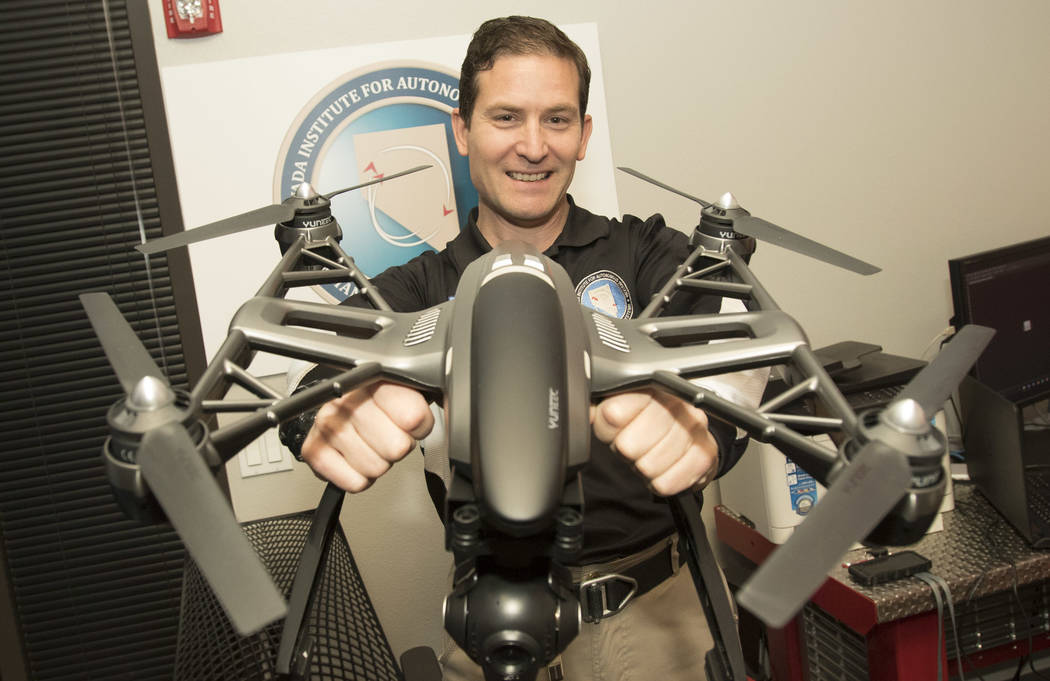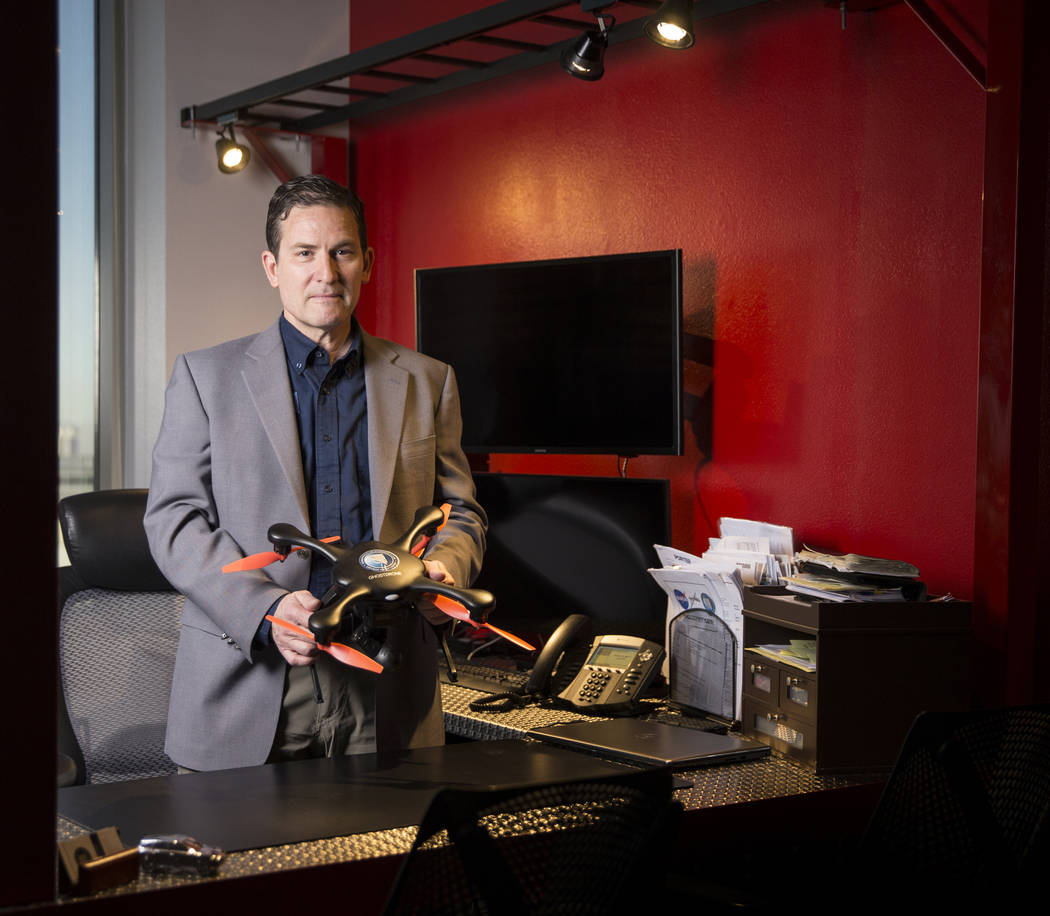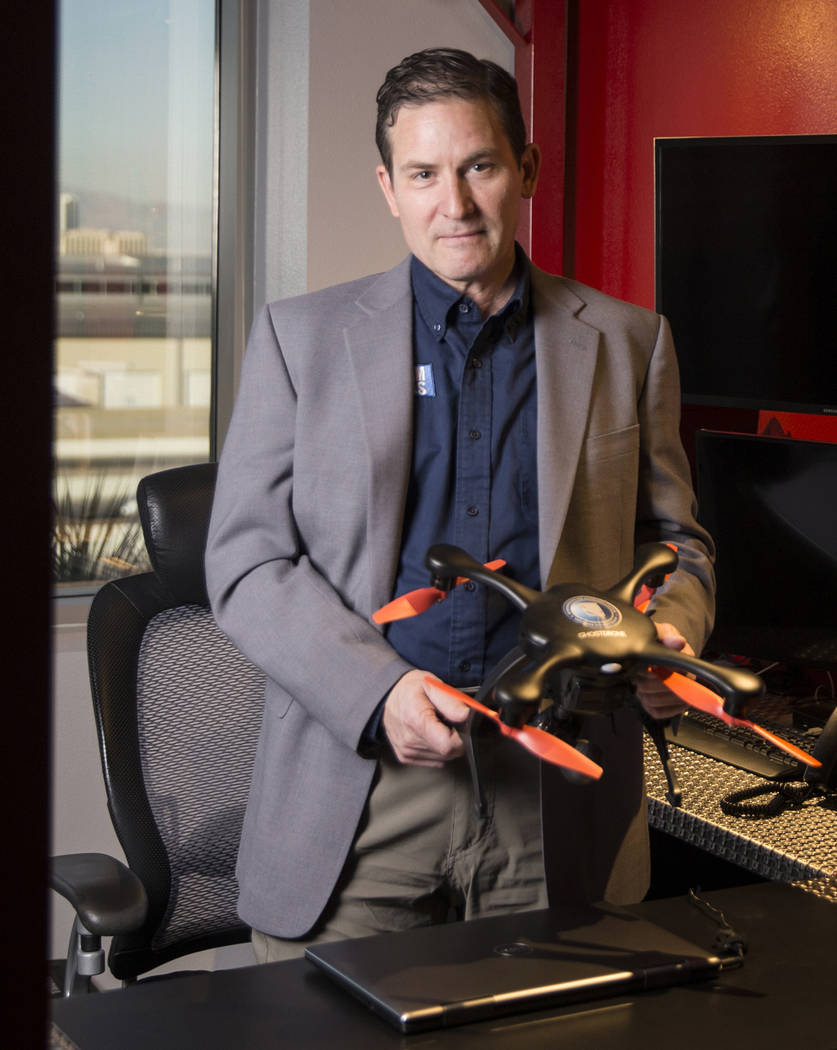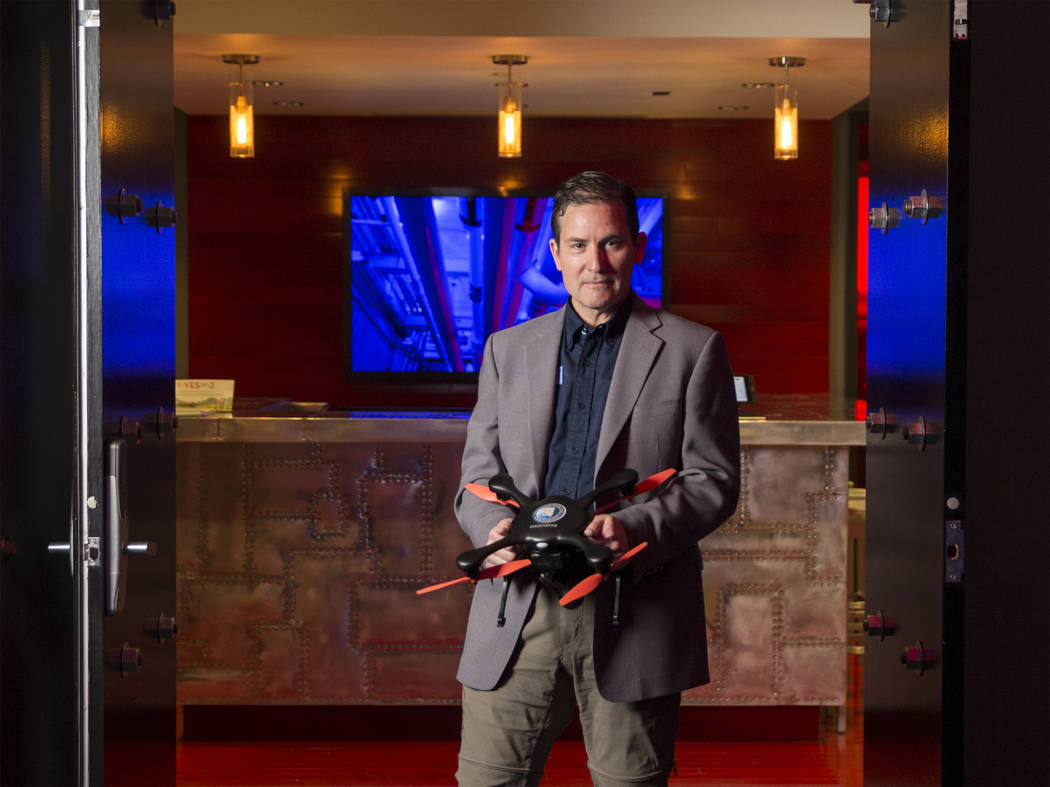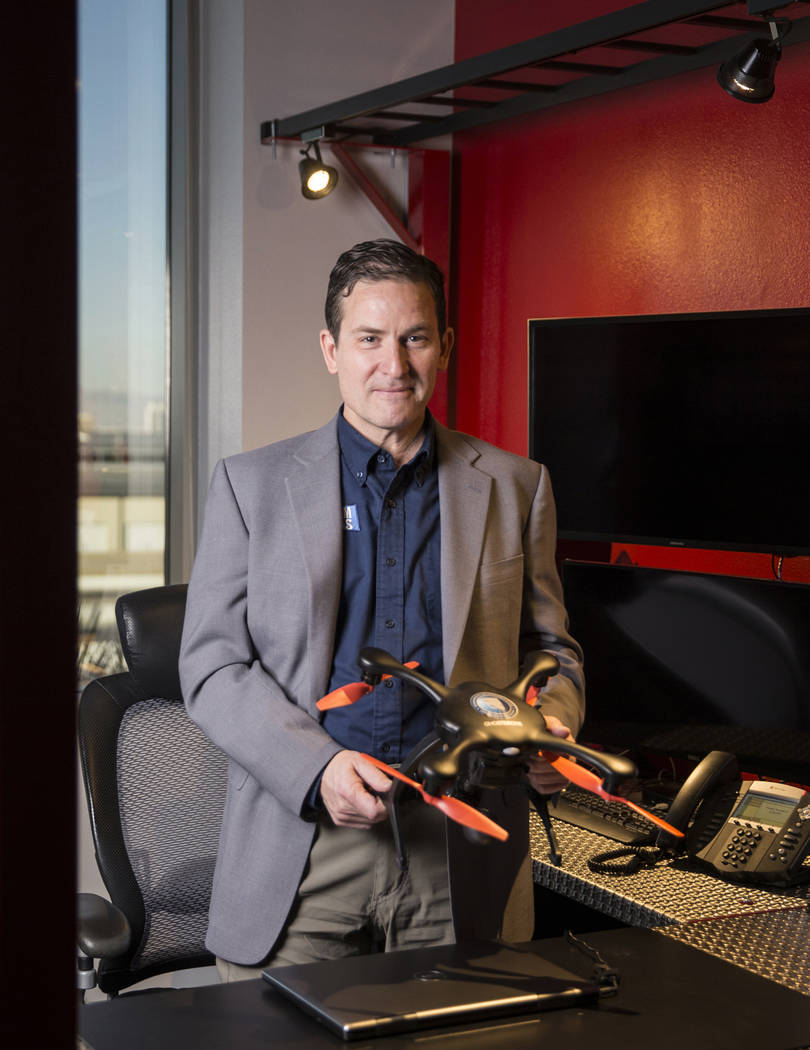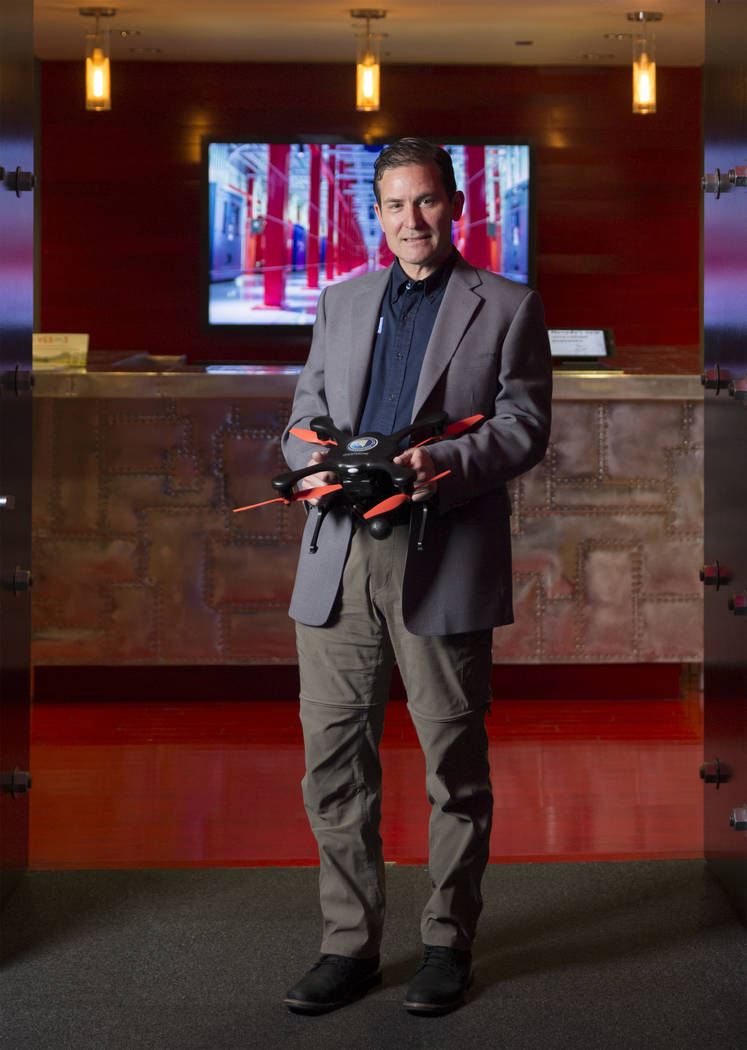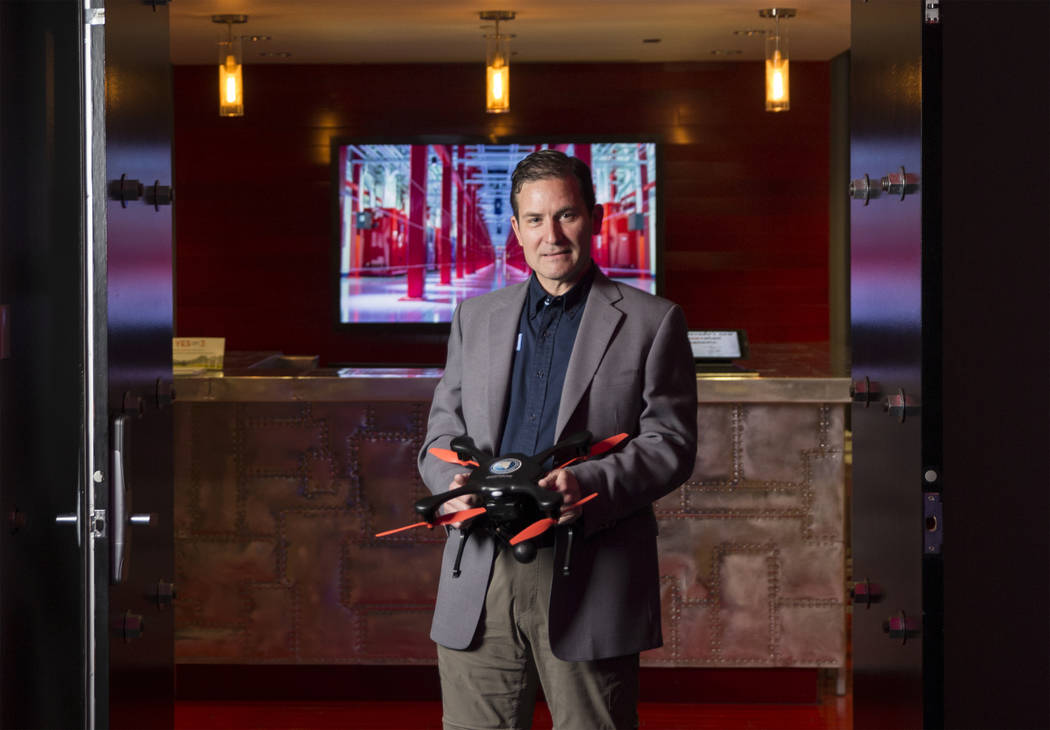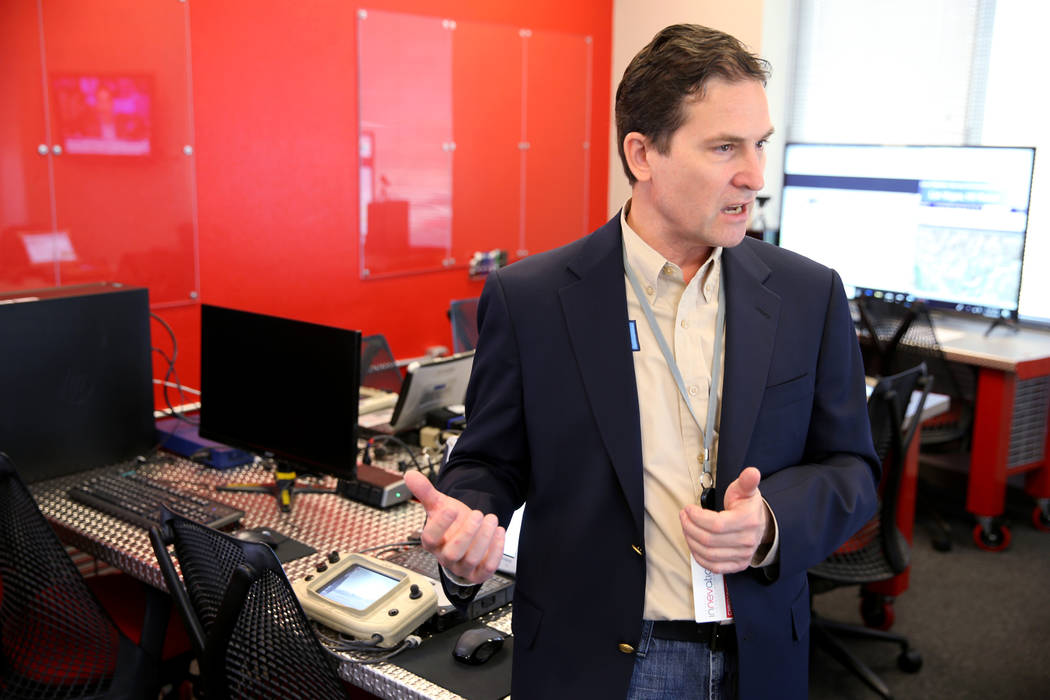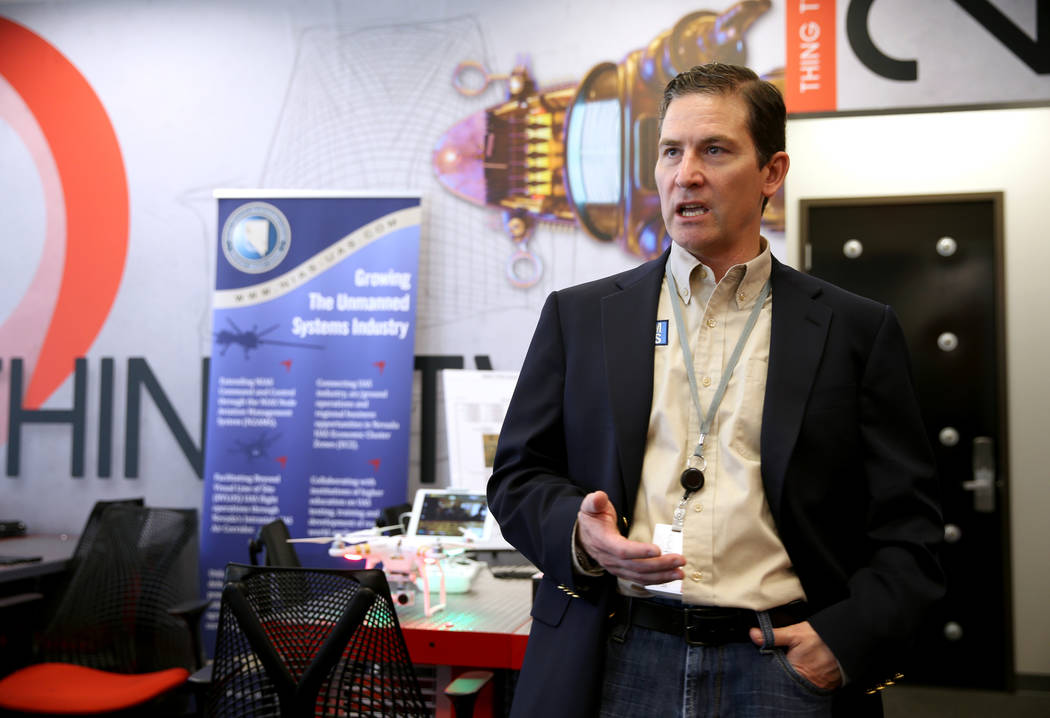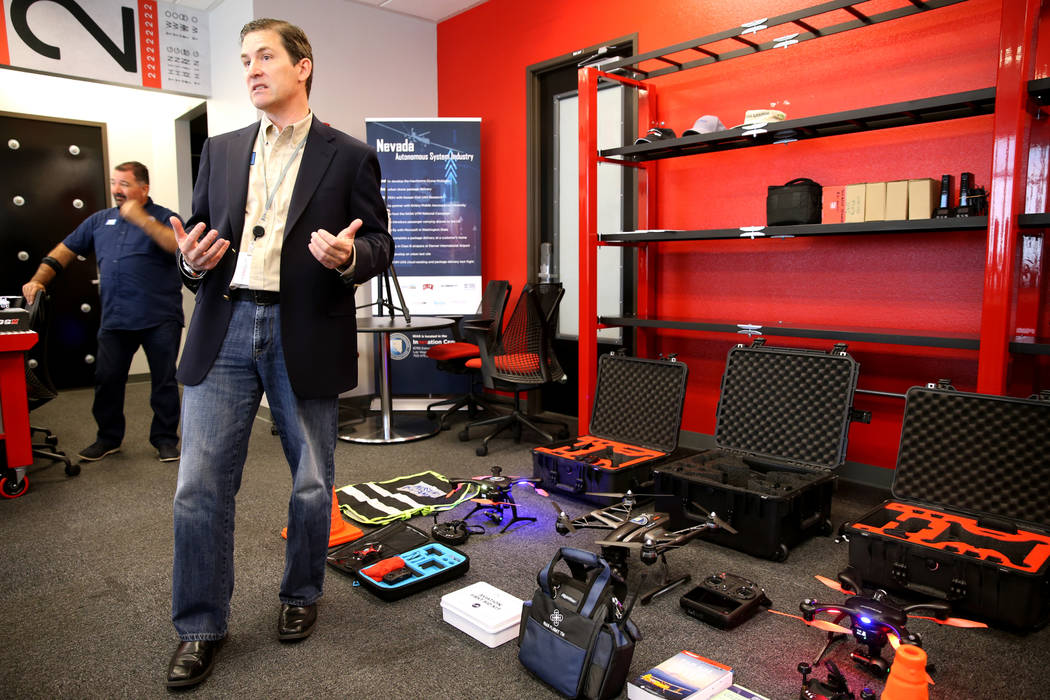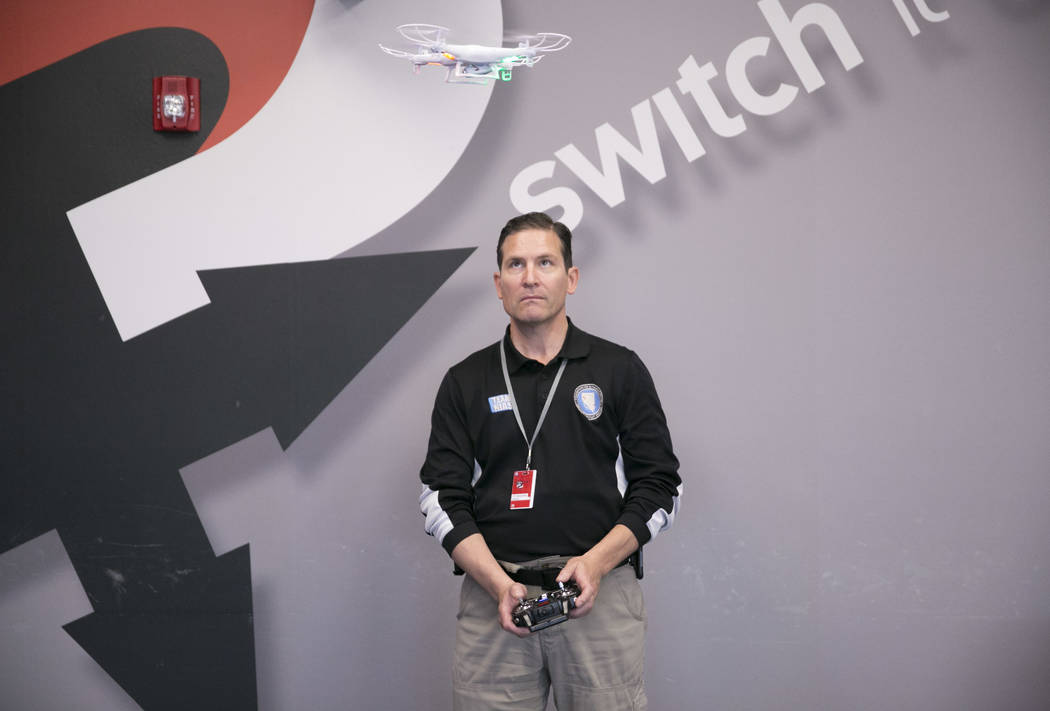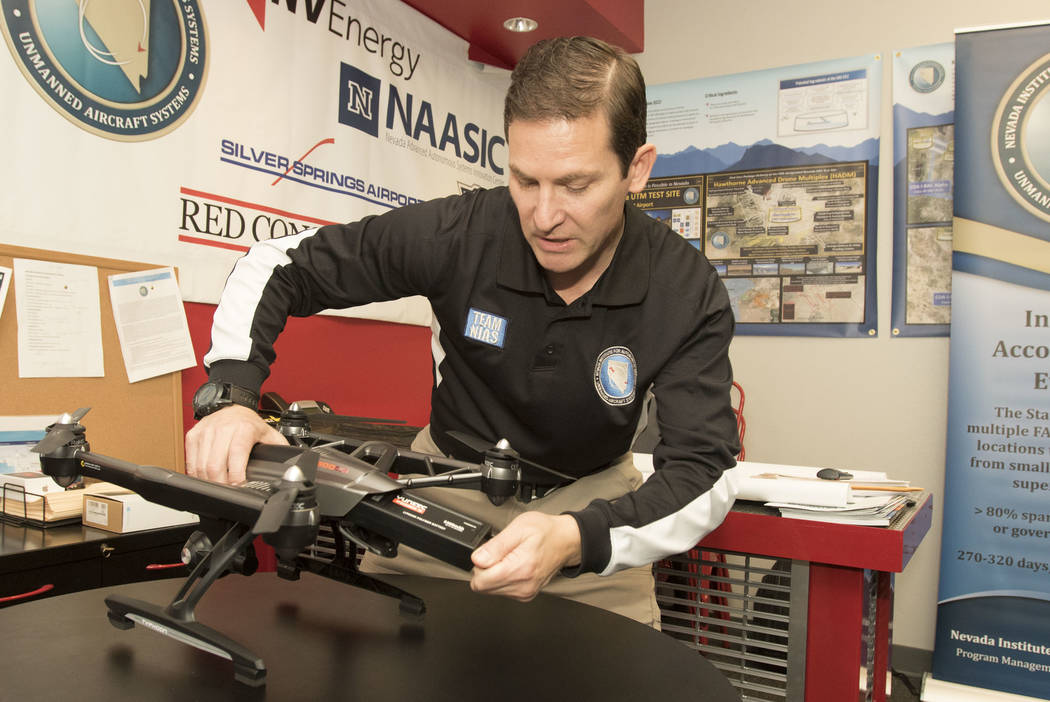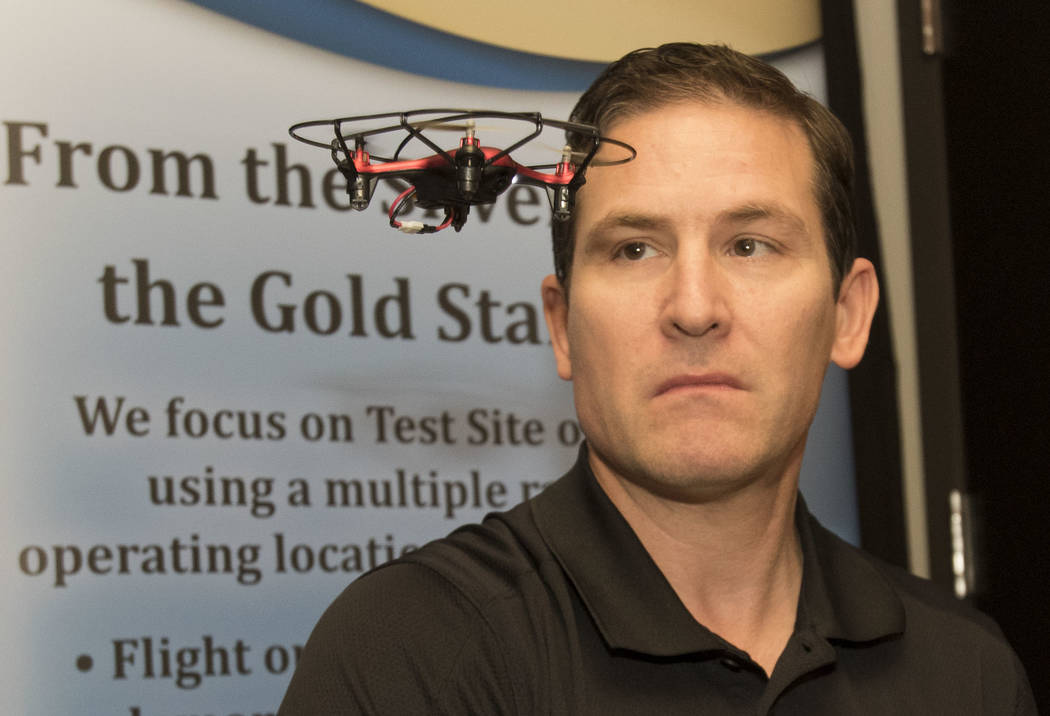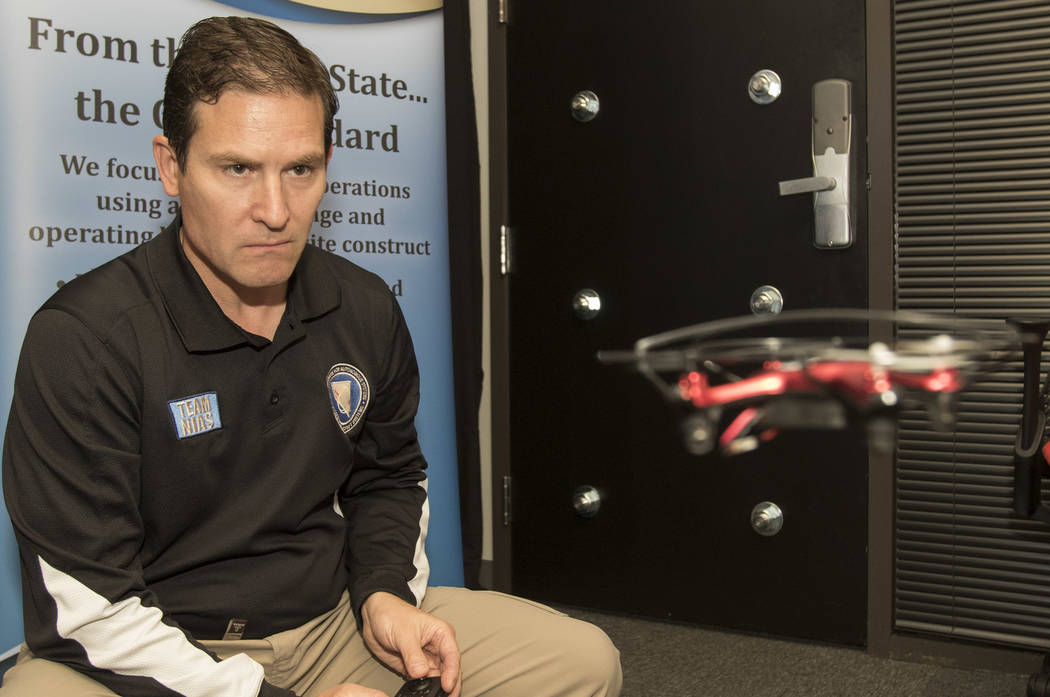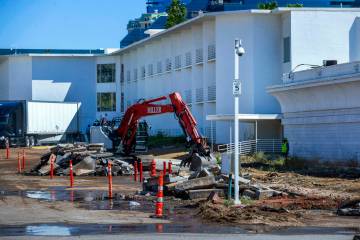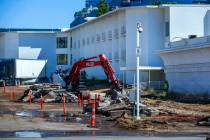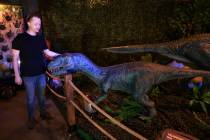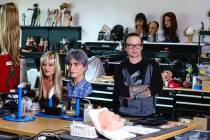Meet the man who’s helped transform Nevada’s drone industry
Take a glance around Chris Walach’s office, and you’ll pick up hints of his past.
His desk inside the Nevada Institute for Autonomous Systems office — bare aside from his computer, his phone and a few sticky notes — speaks to his military background: organized and efficient. Documents stacked to the side are addressed to Dr. Chris Walach, showing how far he has come since dropping out of high school.
In just six years, Nevada’s drone industry has gone from nonexistent to the second most robust in the country. Walach, senior director of the NIAS, is one of the driving forces behind the industry’s growth.
At the end of 2013, Nevada was named one of six Federal Aviation Administration drone test sites in the country and the only one to encompass an entire state. Now it’s home to a center of excellence that promotes public safety in the airspace and has partnered with international companies to advance autonomous systems.
Both of those programs are managed by the NIAS, which also oversees the operations of Nevada’s drone test site.
“There’s definitely been a significant amount of growth” in Nevada’s drone industry, said Gerald Van Hoy, a private consultant for the robotics and drone industries. “Now you’re seeing more commercial applications than you were before. … I’d say that (Nevada is) definitely (a leader) because of the fact that the state has been intelligent about its approach to the drone industry.”
Walach said he leads the NIAS’ focus on using small businesses, research and development and technology demonstrations to advance the local drone industry.
When the Governor’s Office of Economic Development approached Walach about working for the NIAS three years ago, he was immediately interested. He would be able to draw not only on his aviation experience from the Army, but on the problem-solving skills he learned while getting his doctorate.
As senior director, Walach’s role is to collaborate with research institutions, build relationships with companies and attract drone-related businesses to Nevada.
“It was another challenge,” he said.
A different perspective
Walach is used to overcoming difficulties. He spent much of his time on the road growing up, traveling state to state with his three siblings and mother as she looked for work. Sometimes that meant cramming into a single hotel room for the night; other times they’d be homeless and living in the car for weeks.
Eventually, the family settled in Las Vegas. Walach dropped out of Eldorado High School at the end of his sophomore year after feeling like school wasn’t teaching him anything useful. He started his first full-time job at 15 as a busboy, cleaning tables and silverware at a truck stop just off Interstate 15.
“It’s a perspective that will always stick with me,” he said.
After receiving his GED through an accelerated UNLV-led program at Clark County Evening High School, he enrolled in the Army at 17. There, he rose to senior lieutenant colonel, battalion commander and master aviator of an Apache Longbow helicopter unit.
After retiring from the Army in 2008, Walach received Master of Science and Doctor of Management degrees.
“Going after a PhD doctorate, that’s the highest education offered. So that’s what I set out to do,” he said. “If you’re going to do something, you might as well be the best.”
That mindset has followed Walach to the NIAS, where he has set out to make Nevada a global leader in the drone industry — a goal that would have seemed nearly impossible just six years ago.
Rapid growth
Before 2012, Nevada’s drone industry was “nonexistent,” said local attorney Joe Brown, who was appointed to the committee that prepared Nevada’s FAA test site application.
That year, the Nevada Board of Economic Development laid out a plan to help diversify the local economy. The state was still feeling the aftereffects of the great recession, with the unemployment rate more than 3 percent above the national average.
State officials hoped that growing various targeted industries would cushion the state from another major downturn. These included sectors like clean energy, health services and unmanned aerial vehicles.
Brown was one of 15 selected to help expand the latter, and he joined the Nevada Autonomous Systems Panel to coordinate an application for Nevada to become a designated FAA test site.
“We were a long shot,” Brown said. The budget “was almost nothing. … We didn’t have any kind of drone infrastructure or business in a private sector in Nevada.”
But the state beat the odds. In December 2013 — after nearly two years of working to put the state on the map in this industry — Nevada became the only state chosen as a test site. The NIAS was established to oversee the state’s bid for the test side and, eventually, the site’s operations. Today, the FAA looks to Nevada for assistance on drone research and testing.
Five years after its launch, the NIAS reports that it has helped create about 200 jobs in the drone industry, and it expects to create 400 to 500 more in the next year and a half. The institute is also working toward creating an air corridor that would allow drones to fly beyond visual line of sight, and has formed partnerships with international companies to advance technology for future fields like space mining.
“He works well getting people to work together and setting up operations in state and out of state,” said Derek Armstrong, deputy director of the GOED.
Nevada’s future
With all of the work he’s doing for the NIAS — including multiple trips to Poland and Canada to drum up support for partnerships — Brown said he’s unsure how Walach finds the time to sleep.
“He’s the Energizer Bunny,” Brown said. “He just has a lot of drive and works very, very hard.”
Business Facilities magazine ranked Nevada second among states for its drone industry this year, with New York coming in first.
Brown said the local drone industry’s development is going slower than expected with its “shoestring budget,” but he still believes it has the potential to become a major business segment in Nevada.
“I think we’re going to be number one. … Give me five years,” he said. “I think having Chris there, our chances are increased significantly.”
Walach said community ties will help propel Nevada to becoming the leading drone industry in the nation.
“Without having the tens of millions of capital investment into (Nevada’s autonomous system industry) like some other states, we were ranked number two in the nation. That is indicative of the community working together to advance policy and procedures and different unmanned aviation categories,” he said. “My goal is going to have to be working with more of the community and bringing in stakeholders together that have the same common goals for the autonomous systems industry.”
NIAS is working to launch its Institute of Science, Technology, Engineering and Mathematics — or iSTEM — of Drones program. The subsidized program will work to close the achievement gap for students of all ages by exposing them to STEM technology and providing hands-on training to building and designing drones and their software.
“If we’re not pushing STEM from high school to college, we’re going to continue to see the workforce issues that we see (today in Nevada),” Walach said. “If we don’t build that base, we’re going to be lost in the dust by other states or other countries that are investing a lot of money into education, STEM and research and development.”
Contact Bailey Schulz at bschulz@reviewjournal.com or 702-383-0233. Follow @bailey_schulz on Twitter.
O'Callaghan Public Sector Person of the Year Award
On Nov. 15, the City of Henderson's Economic Development and Tourism department presented Chris Walach the O'Callaghan Public Sector Person of the Year Award at the 19th annual Economic Development and Small Business Awards.
Barbra Coffee, director of economic development and tourism for the city of Henderson, said the award recognizes people for their "outstanding contributions to the city" in areas like job growth and business retention.
"We know that economic development is a team sport and isn't done alone by city staff," Coffee said. With these awards, "we're able to recognize partners in the community that make great things happen."
Coffee said Walach's leadership as senior director of NIAS has helped shepherd interest in the emerging autonomous systems industry toward Henderson. In January 2017, the city celebrated the groundbreaking of the Henderson Unmanned Vehicle Range, an urban drone-testing space at Nevada State College overseen by NIAS.
"It's so important for us to align with new and growing industry sectors so we can attract businesses looking to grow and expand operations," Coffee said. "It's definitely opened the door for conversation."
Landing the top spot
Chris Walach said community ties will help propel Nevada to becoming the leading drone industry in the nation.
"Without having the tens of millions of capital investment into (Nevada's autonomous system industry) like some other states, we were ranked number two in the nation. That is indicative of the community working together to advance policy and procedures and different unmanned aviation categories," he said. "My goal is going to have to be working with more of the community and bringing in stakeholders together that have the same common goals for the autonomous systems industry."
NIAS is working to launch its Institute of Science, Technology, Engineering and Mathematics — or iSTEM — of Drones program. The subsidized program will work to close the achievement gap for students of all ages by exposing them to STEM technology and providing hands-on training to building and designing drones and their software.
"If we're not pushing STEM from high school to college, we're going to continue to see the workforce issues that we see (today in Nevada)," Walach said. "If we don't build that base, we're going to be lost in the dust by other states or other countries that are investing a lot of money into education, STEM and research and development."



